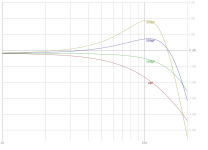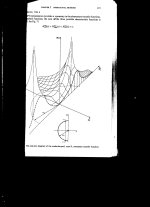I have owned this cartridge for two decades. It has always been a bit bright. Audio-Technica recommends 100-200pF total load for the turntable, cable, and preamp. This is a low value.
I estimate my system had ~300pF. So, I removed the 100pF loading capacitors from my DIY preamp.
The difference is apparent. The AT440ML now sounds smooth. 🙂
The Internet has a lot of posts about brightness in Audio-Technica's current models. If you own one, make sure that the capacitive loading is under 200pF. 47K resistance works well.
Ed
I estimate my system had ~300pF. So, I removed the 100pF loading capacitors from my DIY preamp.
The difference is apparent. The AT440ML now sounds smooth. 🙂
The Internet has a lot of posts about brightness in Audio-Technica's current models. If you own one, make sure that the capacitive loading is under 200pF. 47K resistance works well.
Ed
Attachments
I did some A/B comparisons of records and CDs of the same material (Windham Hill). The two are indistinguishable at my normal low listening levels. That is remarkable for a record. 🙂
Ed
Ed
Lowering the resistance would be the next step if the capacitance cannot be made low enough. Going from 47K to 33K reduces the response at 20KHz by 3dB.
Ed
Ed
Glad you have noticed this. The AT generator is capable of very flat performance (dare I say up with the best) if you get the capacitance under control. A total of 150pF would be ideal but as the cables alone can account for all of that you need a phono stage with low input C and removable loading capacitors.
billshurv - I was impressed by your measurements of the AT150MLX. I figured the AT440ML should do nearly as well.
Brass instruments on a big-band direct disk sound just right.
Ed
Brass instruments on a big-band direct disk sound just right.
Ed
It's the same generator between the two, and one could argue that the 440 is the better cartridge due to lower mass, but the 150 does look shiny!
Throughput of the electric circuit is just one half of the story. However, mechanical system has it's own transfer characteristic, so the overal response is combination of these two. Maybe in some cases it's better to have some freq deviation in electric circuit to compensate for nonlinearities in mechanical.I have owned this cartridge for two decades. It has always been a bit bright. Audio-Technica recommends 100-200pF total load for the turntable, cable, and preamp. This is a low value.
I estimate my system had ~300pF. So, I removed the 100pF loading capacitors from my DIY preamp.
The difference is apparent. The AT440ML now sounds smooth. 🙂
The Internet has a lot of posts about brightness in Audio-Technica's current models. If you own one, make sure that the capacitive loading is under 200pF. 47K resistance works well.
Ed
Generally I agree that standard 47k 100+pF input is not always the optimum.
Actually the mechanical circuit on AT carts is very well behaved. Maybe a 2dB rise at 18kHz with 47k||150pF.
I would expect the lower resistive load would physically dampen the mechanical system as well as altering the RLC electrical environment. Some more of the generator current becomes heat rather than being stored and released.
Electromechanical coupling of the cantilever is very weak (unlike the motor coil of a dynamic speaker). So few more nA in the coil is insufficient for detectable dampening effect.
How do we know if these 2dBs are due to mechanical/electrical resonance?Actually the mechanical circuit on AT carts is very well behaved. Maybe a 2dB rise at 18kHz with 47k||150pF.
Hans has posted a paper on the measurements we did. He's pretty accurately split the two.
Don’t depend on the manufacturer to give you information on the cartridge termination that sounds the best. They terminate their cartridge for flattest frequency response, and they do this by peaking the electrical response by using an electrical Q greater than 0.707. Back in the 1970s I tried various terminations and went so far as to put my preamp in the plinth beneath the tone arm to minimize the cable capacitance between the arm and preamp. I decided that you just aim for a Q of 0.6 and to heck with the frequency response. There will be more attenuation at the high end but there isn’t much music out there so you shouldn’t care. Why a Q of 0.6? That’s because it’s almost phase linear. If you look at the Q of a two pole phase linear Bessel filter, the poles require a Q of 0.57, so 0.6 is close enough. I found a picture of a two pole frequency response in an old text and it shows what you are dealing with. You have a zero at the origin (the cartridge doesn’t produce DC) and at infinity (the cartridge doesn’t reproduce to infinity) and two poles you can move around. You can’t do much with two poles, so just go for phase linear. I think that sounds best.
Attachments
I'd like to read that - can you point to its location? Thanks 🙂Hans has posted a paper on the measurements we did. He's pretty accurately split the two.
The paper is here. https://www.diyaudio.com/community/...rts-with-individual-transfer-functions.397815
I find that my records have bigger equalization errors than my playback equipment. The records were mostly from the 70s and 80s.
Ed
I find that my records have bigger equalization errors than my playback equipment. The records were mostly from the 70s and 80s.
Ed
- Home
- Source & Line
- Analogue Source
- Tamed the AT440ML

